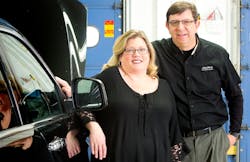Jen Fisher has had what many people would call a fairly standard industry past—she grew up in the business, and recalls her dad’s collision shop being a large part of her family’s life.
But just because she grew up in the business doesn’t mean she knows how to run the business.
After graduating high school, she moved away and joined the printing industry, where she met her now husband Gary Fisher. Today, they both manage Jen’s dad’s shop, Jay-Bee Collision Repair Center in Kenosha, Wis.
With Jen and Gary shifting careers and Jen’s father currently semir-retired, the Fishers felt that stepping into the fast-changing collision repair industry was the next natural step. But in order to effectively run Jay-Bee, they had to tap into their expertise—from the printing industry, of all places.
Everything from scheduling to production to leadership to customer service, the two have used their backgrounds to turn an already successful $2.2 million shop into a more efficient machine.
The Printing Advantage
After spending a combined thirty-plus years in the printing industry, both Gary and Jen have found that their professional backgrounds have allowed them to hold the foundational skills they need to manage a shop.
For Jen, after coming back to the shop in February 2005, her background in production planning allowed her to have a strong understanding of how steps and processes affect each other. In each production meeting, she is able to compile a list of priorities when it comes to scheduling.
If a technician has four cars he or she is working on, the order in which the employee works on those vehicles may make sense to the technician, but not to the overall function of the business, she says.
Her background; however, has helped inform her leadership style. In her previous career, she always collaborated with other department managers, which reinforced the importance of collaboration. Her efforts in leading her shop team are always more collaborative, as she says she’s not good at telling people what to do or how to do it.
With Gary’s background in manufacturing, he says the issues in collision repair are very similar and require sufficient training. Gary, who joined the shop in April 2007, also acts as one of the blueprinting estimators, and says it’s crucial to decipher all the technical information to make sure a repair is done properly.
The only true obstacle, Jen says, was that it was a transition coming from a large corporate environment, with hundreds of employees, to a family business where everyone is wearing multiple hats. Learning how to do various jobs was different then having one defined role.
The Printing Principles:
Put Customers First.
A strong focus on customer satisfaction has allowed Jen and Gary to look at the bigger picture.
“Printing was very customer focused. Because it was such a competitive focus, you were not only looking to meet, but exceed, customer satisfaction and for both Jen and I, it has suited us to deal well with our customers,” Gary says.
Judging from the reactions he gets from customers, Gary sometimes senses that competing shops won’t write estimates if the ticket doesn’t present a high ARO.
Gary has used that as an opportunity to build relationships with customers—even if the profit isn’t there. For simple scratches, Gary will recommend a $50 buff, versus a full $800 paint job.
“We believe it garners trust,” he says.
Jen likes to give customers options for their repairs. For example, if it’s customer-pay work, the shop will present various price options on parts. Jen and Gary believe this is all part of the education process.
“We take a lot of pride in taking the time with the customer,” Gary says. “We don’t just write the estimate, tell them how much it is, hand it to them and then send them out the door. We take the time whether we’re going to get the job or not to help them understand the process that they’re about to embark in.”
Treat People Fairly and Right.
It’s that customer-focused attitude they look for when hiring technicians. The Fishers say infusing the attitude of “taking care of the little things” wasn’t even difficult because the staff was already on board—a testament to hiring the right people.
“We try to remind them that what’s good for the shop is good for them,” Jen says.
“I believe all of our technicians have that attitude … everyone here has always looked to do a little extra,” Gary adds.
He recalls a time where one of his techs was working on a car with some rust underneath it. While the tech could charge a few hours for taking care of it, he knew he couldn’t warranty it, so he did it for no charge.
But for Gary and Jen, it’s key that employees are treated fairly. Gary says that it’s like raising kids; in a technician environment, you have different people who have different operating buttons. Some techs need praise, others need sternness, while the rest just need a simple reminder.
It’s all about knowing those on your team and understanding how to work with them.
Know the End Goal.
Whether it’s printing or collision repair, the end goal is customer satisfaction—that’s what everything stems from, Gary says. Understanding your business’s goals will help you not only operate better, but also make the right business decisions.
For Gary and Jen, the end goal is going above and beyond for customers, both by creating solid customer relationships and becoming involved in the community.
Community involvement is extremely important to Jen, as it helps her connect with her customers outside shop walls. That’s been a part of the shop’s philosophy since her dad took over, and is also responsible for the shop’s largest channel of marketing.
Jen has been on the board of the local Boys & Girls Club for 11 years, took her dad’s place on the chamber of commerce board, and is part of the area Rotary International Club.
“We feel it’s important as a family-owned business in the community that we want to keep our community strong,” Jen says. “We’re part of it, too, and we owe it to give back and help those that need it.”
The 'Lean Transition'
The couple was never in a rush to implement change. If anything, Gary says that operators have to be careful of changing too much at once because it can cause disaster. The two decided to take things slow and alter processes as needed.
For Jen, she had to find her true role in the shop. She spent the first year observing those around her. And when the original shop manager retired soon after Jen started, she says it pushed her to pick things up—quickly.
Trying to fill the void, Jen had no choice but to take over production. While she was able to get by, it prompted her to join a 20 Group in 2006 with industry consultant Mike Anderson. Here are the plans of action that resulted from that training:
Scheduling: When the old production manager retired, Jen changed daily production scheduling.
Instead of writing out the schedule on Friday (with edits being made throughout the week), Jen moved the schedule into Excel, where she could update it daily.
She also made the production schedule daily versus weekly.
Bookkeeping: After handling production for a while and going to several 20 Group meetings, Jen decided to get a new management system for the shop. She says the old system was basically just used as a time clock and did nothing but leave paper trails for parts on file.
The new system allows them to order parts electronically and better manage payroll, versus Jen’s father needing to sit down with each of the technicians and flag hours each week.
Parts System: Relying heavily on jobbers and clip suppliers, the amount of overstock the shop suffered was unbelievable, Jen says. Jobbers were ordering parts they thought the shop needed or would never run out of, so products piled up. There was so much stuff that it took Gary two years to reduce all the overage.
He started by barcoding products to electronically keep track of them. The techs were then to order only products they need on a weekly basis. Gary also uses Autoclip as his clip vendor, who supplies him with software that worked well for tracking.
This resulted in eliminating $10,000 in overstock inventory.
While both Jen and Gary no longer participate in the 20 group, they continue to use the same principles that they’ve learned, in the business today.
SHOP STATS: JAY-BEE COLLISION REPAIR CENTER Location: KENOSHA, WISC. Average Monthly Car Count: 100-120 Staff Size: 17 Shop Size: 12,000 sq ft; Annual Revenue;$2.2 Million



